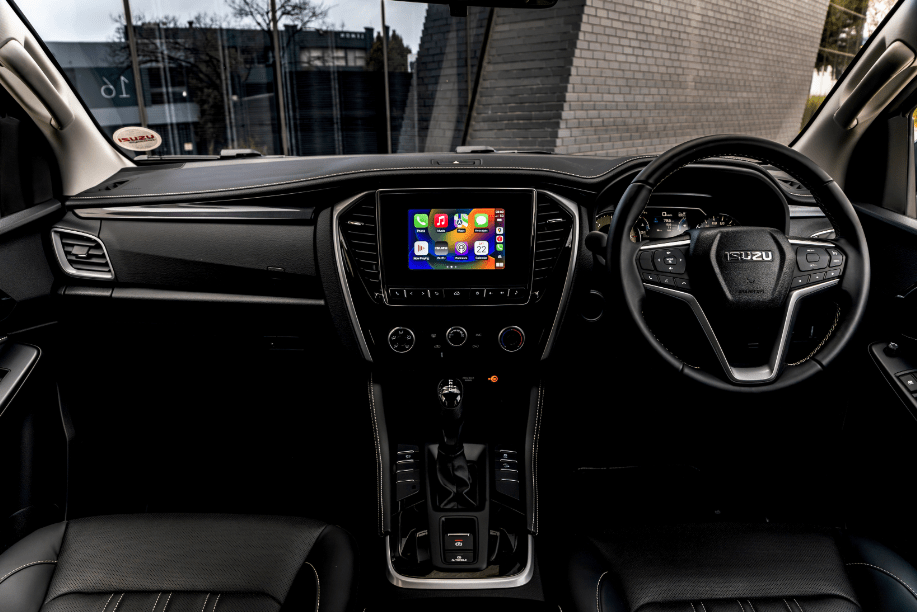The Isuzu mu-X has an attractive exterior and, although the engine lacks oomph, there is very little not to like about this well-equipped and solidly built SUV
The Isuzu mu-X has come a long way from the introduction of the MU-7 in 2004. That was all KB in the front, FBI-esque field response vehicle on the sides and, if you squinted hard enough, there was some Ford Explorer at the rear. It’s hard to imagine anyone calling it good-looking, even at the time.
Now, its spiritual successor, the mu-X, which is also the replacement for the dearly departed Chevrolet Trailblazer, is already in its second generation and based on the same ladder-frame chassis that does service in the well-loved D-Max.
The mu-X, unlike the MU-7, does look good, even at the bottom end of the scale where the 1.9TD LS reigns supreme. It’s also the model we had on test and here’s the kicker — I had to double-check the catalogues to make sure that it is, in fact, at the bottom of the totem pole.
On the inside, it’s all very upper mid-range. The build quality, for one, is solid in that typical hard-wearing Isuzu way that’s intended to outlast five generations of muddy-footed rugrats.
In the middle of the dashboard is a modest seven-inch touchscreen infotainment system that offers plug-in Android Auto capabilities and a more streamlined and glitch-free experience than many R2 million-plus vehicles.
 The Isuzu mu-X’s interior boasts a seven-inch touchscreen infotainment system that gives a more streamlined and glitch-free experience than many other vehicles that cost twice as much, and comfortable seats.
The Isuzu mu-X’s interior boasts a seven-inch touchscreen infotainment system that gives a more streamlined and glitch-free experience than many other vehicles that cost twice as much, and comfortable seats.
It’s all very easy to operate. Park distance, traction and hill-descent control are a mere hand’s reach away, all the air-conditioning control functions are laid out in a yay or nay for AC way, while rotary dials exist to tweak the specifics.
If only all carmakers could consider ergonomics like this. Even the cloth and faux-leather combo seats are form-hugging.
The LS, as you’ve probably gleaned, is powered by the 1.9-litre turbodiesel mill that produces a pedestrian 110kW and 350Nm of torque.
It’s also here where things go pear-shaped as the puny 1.9-litre doesn’t feel entirely up to the task of getting 1 900kg of SUV (that’s without passengers) off the line at a stop street.
Its hesitation due to the turbo lag is almost painful but, once it gets going, the six-speed auto reliably shifts through its gears. Until, of course, you plant your foot on the loud pedal when, again, the mechanical cogs turn with indecision.
The steering too errs on the lifeless side with little in the way of communication. But, then again, the mu-X was never intended to tackle fast sweeps with seven passengers in tow.
As for ownership, the mu-X 1.9TD LS makes a decent case for itself at R708 000. It’s a smidge more than the equivalent Toyota Fortuner 2.4GD-6 auto 4×2 at R699 800, which has a superior powertrain, but is now getting seriously long in the tooth.
On the other end of the spectrum, the most affordable Ford Everest is R843 300, so that’s probably a no-go if you are considering the LS as a value-first offering. Who says we don’t offer sensible buying advice?
Overall, the mu-X LS is a respectable option among family SUVs, despite the unfortunate fact that its engine falls short of both modern expectations for power delivery and that of the direct competition.
If you can live with that, though, there’s very little not to love about Isuzu’s entry-level SUV. It’s good-looking, exceedingly well-equipped (considering the absence of 4×4 capabilities) and, most importantly, it feels a far cry from the dreaded entry-level point.
In a market where bottom-of-the-range cars exist solely to upsell buyers into something damn-near unaffordable, I commend Isuzu for creating a solid product that has an actual want factor.